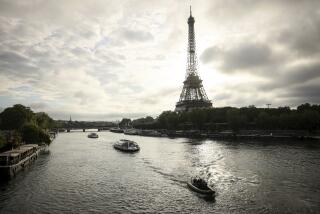Swim in New York’s East River? A floating pool plan envisions a safe way
- Share via
Reporting from NEW YORK — On hot summer days, Dong-Ping Wong does what many New Yorkers do; he heads to the riverfront.
But then he wants to do what only die-hards would do: go for a swim.
“There’s this giant body of water, but as a city dweller, you don’t ever think that it’s something you can get into,” said Wong, an architect and designer. “It took me six or seven years before I thought about looking at the river as actual water. It was something that separated Brooklyn and Manhattan, something the bridge went over or the tunnel went through.
“It was absurd,” he said, “that you couldn’t touch it and use it.”
He set out to change that, which led to a design concept that is at best several summers away but already has much of New York City buzzing: a colossal four-pronged pool that not only will float within the river itself but will use the river as its water source, filtering an estimated 500,000 gallons a day, even as swimmers do laps and belly flops. And the East River, which separates Manhattan from Brooklyn and Queens, is its likeliest future home.
The pool idea is part of a broader trend in New York City, which had long turned its back to its riverfronts but now is looking to reclaim more than 500 miles of shoreline from decades of contamination and neglect.
Wong’s design, which consists of four full-sized rectangular pools that when seen from above form a gigantic plus sign, must win approval from the city and at the moment carries a $21-million price tag. Public funding cannot be sought until the design clears the city’s complex permitting process, yet the concept has won support from Google Inc., as well as high-profile advisors with engineering firm Arup and design group Ideo.
A small test float launched last spring proved the filtration concept could work, Wong said, and Google streamed a live data dashboard that tracked water quality in real time. The study showed that the filters could scrub away bacteria and chemical pollution via multiple layers of porous material as the water flowed through.
That is why organizers say the so-called Plus Pool is as much about changing perceptions as it is about good design.
Despite improvements, New York’s rivers struggle with frequently unsafe levels of sewage after a rainfall, and the city’s harbor remains plagued by leftover industrial chemicals. More than 27 billion gallons of raw sewage and polluted stormwater flow into New York Harbor each year, according to the clean water advocacy group Riverkeeper. Supporters of the pool design are confident the filtering system will be a game-changer.
City Councilman Stephen Levin, whose district includes the Brooklyn waterfront neighborhoods where the pool could one day be located, is confident the idea is part of a bigger environmental push.
“It’s part of this overall movement of reclaiming our harbor for 21st century purposes,” he said. “I would go there in a second.”
The city is moving in that direction. Mayor Bill de Blasio has pledged more than $100 million in park investments and upgrades. High-profile projects have repurposed disused or abandoned spaces into major city attractions: Brooklyn Bridge Park reclaimed abandoned government-owned piers, and the High Line park was built atop a defunct elevated railroad.
No one denies money will be an issue for the Plus Pool, although two online Kickstarter campaigns have helped get things rolling, bringing in more than $500,000. But winning city approval is key, and that can be a daunting process.
“The permitting and regulatory scheme that they launched themselves into bravely is still demanding and challenging,” said Roland Lewis, president of the environmental advocacy group Metropolitan Waterfront Alliance and a veteran of city planning debates. “But the more .... innovative things on the waterfront, the better off we’ll all be.”
Open-water swimmers — the hardy citizens who already brave the city’s waterways, often for races and triathlons — say they are eager for the pool to make its debut.
“The concept that the pool could filter the river water would make it accessible to a lot more people,” said Deanne Draeger, the founder of Urban Swim, a group that holds an annual 17-mile swim from Manhattan to Brooklyn’s Coney Island. “Right now, it’s not something where someone can just jump in and swim safely.”
Those who swim in the water today are a determined group, tackling strong currents even on days when ice is visible on the surface. Draeger says the pool needs to be similarly tough.
“It’s kind of a gnarly water environment out there,” she said. “But once something’s available and addresses the issues that most people have, it will definitely shift a lot of people’s attitudes.”
What is really giving lift to the idea, though, is New York’s past. Urban planner Ann Buttenwieser years ago discovered the history of the city’s floating baths in the East and Hudson rivers between the 1870s and the 1920s.
The basic platforms came with dressing rooms and were intended for the city’s growing immigrant population in tenement neighborhoods where there was little running water, she said. A dip into the East River would have been a respite from heat and dirt — and more than 1 million people are on record using them in a single year.
Buttenwieser led the charge for bringing the idea back to life. In 2007, she unveiled a custom-designed pool built on a barge, which still welcomes swimmers each summer in a corner of the South Bronx. She said being inside a pool on the river is unlike any other swimming experience.
“You realize you’re in the water and you’re completely safe,” said Buttenwieser, affectionately known here as the “Floating Pool Lady,” which is also the name of the barge.
“One of the things a floating pool creates is a constituency for people to clean up the river,” she said.
As she worked for decades to bring the concept back to the city, she soon saw what made New York City ideal for floating pools, especially Wong’s concept.
“I was thinking ... most people lived on islands,” she said, “and yet people had no idea there was a waterfront.”
Wong and his partners couldn’t agree more.
As Archie Coates IV, one of those partners, put it: “Let’s build this thing in the river that changes the way New Yorkers look at their rivers.”
More to Read
Sign up for Essential California
The most important California stories and recommendations in your inbox every morning.
You may occasionally receive promotional content from the Los Angeles Times.













